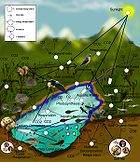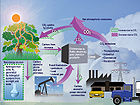- Metabolic theory of ecology
-
The metabolic theory of ecology (MTE) is an extension of Kleiber's law and posits that the metabolic rate of organisms is the fundamental biological rate that governs most observed patterns in ecology.[1]
MTE is based on an interpretation of the relationships between body size, body temperature, and metabolic rate across all organisms. Small-bodied organisms tend to have higher mass-specific metabolic rates than larger-bodied organisms. Furthermore, organisms that operate at warm temperatures through endothermy or by living in warm environments tend towards higher metabolic rates than organisms that operate at colder temperatures. This pattern is consistent from the unicellular level up to the level of the largest animals on the planet.
In MTE, this relationship is considered to be the single constraint that defines biological processes at all levels of organization (from individual up to ecosystem level), and is a macroecological theory that aims to be universal in scope and application.[1]
Contents
Theoretical background
Metabolic rate scales with the mass of an organism of a given species according to Kleiber's law where B is whole organism metabolic rate (in watts or other unit of power), M is organism mass (in kg), and Bo is a mass-independent normalization constant (given in a unit of power divided by a unit of mass. In this case, watts per kilogram):
At increased temperatures, chemical reactions proceed faster. This relationship is described by the Boltzmann factor, where E is activation energy in electronvolts or joules, t is absolute temperature in kelvins, and k is the Boltzmann constant in eV/K or J/K:
While Bo in the previous equation is mass-independent, it is not explicitly independent of temperature. To explain the relationship between body mass and temperature, these two equations are combined to produce the primary equation of the MTE, where bo is a normalization constant that is independent of body size or temperature:
According to this relationship, metabolic rate is a function of an organism’s body mass and body temperature. By this equation, large organisms have proportionally higher metabolic rates (in Watts) than small organisms, and organisms at high body temperatures have higher metabolic rates than those that exist at low body temperatures.However specific metabolic rate (SMR, in Watts/kg) is given by

Hence SMR for large organisms are lower than small organisms.
Controversy over exponent
There is disagreement amongst researchers about the most accurate value for use in the power function, and whether the factor is indeed universal.[2] The main disagreement is whether metabolic rate scales to the power of 3/4 or 2/3. The majority view is currently that 3/4 is the correct exponent, but a large minority believe that 2/3 is the more accurate value.[2] Although a rigorous exploration of the controversy over choice of scaling factor is beyond the scope of this article, it is informative to understand the biological justification for the use of either value.
The argument that 2/3 should be the correct scaling factor is based on the assumption that energy dissipation across the surface area of three dimensional organisms is the key factor driving the relationship between metabolic rate and body size.[2] Smaller organisms tend to have higher surface area to volume ratios, causing them to lose heat energy at a faster rate than large organisms. As a consequence, small organisms must have higher specific metabolic rates to combat this loss of energy over their large surface area to volume ratio.
In contrast, the argument for a 3/4 scaling factor is based on a hydraulic model of energy distribution in organisms, where the primary source of energy dissipation is across the membranes of internal distribution networks. This model is based on the idea that metabolism is essentially the rate at which an organism’s distribution networks (such as circulatory systems in animals or xylem and phloem in plants) deliver nutrients and energy to body tissues.[3] It therefore takes longer for large organisms to distribute nutrients throughout the body and thus they have a slower metabolic rate. The 3/4 factor is then derived from the observation that selection favors a fractal or near-fractal distribution network for space-filling circulatory systems.[3] All fractal networks terminate in identical units (such as capillary beds), and the number of such units in organisms is proportional to a 3/4 power relationship with body size.[3]
Despite the controversy over the value of the exponent, the implications of this theory would remain true regardless of its precise numerical value.
Implications of the theory
The metabolic theory of ecology’s main implication is that metabolic rate, and the influence of body size and temperature on metabolic rate, provide the fundamental constraints by which ecological processes are governed. If this holds true from the level of the individual up to ecosystem level processes, then life history attributes, population dynamics, and ecosystem processes could be explained by the relationship between metabolic rate, body size, and body temperature.
Organism level
Small animals tend to grow fast, breed early, and die young.[4] According to MTE, these patterns in life history traits are constrained by metabolism. An organisms’ metabolic rate determines its rate of food consumption, which in turn determines its rate of growth. This increased growth rate produces trade-offs that accelerate senescence. For example, metabolic processes produce free radicals as a by-product of energy production.[5] These in turn cause damage at the cellular level, which promotes senescence and ultimately death. Selection favors organisms which best propagate given these constraints, so as a result smaller, shorter lived organisms tend to reproduce earlier in their life histories.
Population and community level
MTE has profound implications for the interpretation of population growth and community diversity.[4] Classically, species are thought of as being either r selected (where population size is limited by the exponential rate of population growth) or K selected (where population size is limited by carrying capacity). MTE explains this diversity of reproductive strategies as a consequence of the metabolic constraints of organisms. Small organisms and organisms that exist at high body temperatures tend to be r selected, which fits with the prediction that r selection is a consequence of metabolic rate.[1] Conversely, larger and cooler bodied animals tend to be K selected. The relationship between body size and rate of population growth has been demonstrated empirically,[6] and in fact has been shown to scale to M-1/4 across taxonomic groups.[4] The optimal population growth rate for a species is therefore thought to be determined by the allometric constraints outlined by the MTE, rather than strictly as a life history trait that is selected for based on environmental conditions.
Observed patterns of diversity can be similarly explained by MTE. It has long been observed that there are more small species than large species.[7] In addition, there are more species in the tropics than at higher latitudes.[1] Classically, the latitudinal gradient in species diversity has been explained by factors such as higher productivity or reduced seasonality.[8] In contrast, MTE explains this pattern as being driven by the kinetic constraints imposed by temperature on metabolism.[9] The rate of molecular evolution scales with metabolic rate,[10] such that organisms with higher metabolic rates show a higher rate of change at the molecular level.[1] If a higher rate of molecular evolution causes increased speciation rates, then adaptation and ultimately speciation may occur more quickly in warm environments and in small bodied species, ultimately explaining observed patterns of diversity across body size and latitude.
MTE’s ability to explain patterns of diversity remains controversial. For example, researchers analyzed patterns of diversity of New World coral snakes to see whether the geographical distribution of species fit within the predictions of MTE (i.e. more species in warmer areas).[11] They found that the observed pattern of diversity could not be explained by temperature alone, and that other spatial factors such as primary productivity, topographic heterogeneity, and habitat factors better predicted the observed pattern.
Ecosystem processes
At the ecosystem level, MTE explains the relationship between temperature and production of biomass. The average production to biomass ratio of organisms is higher in small organisms than large ones.[12] This relationship is further regulated by temperature, and the rate of production increases with temperature.[13] As production consistently scales with body mass, MTE predicts that the primary factor that causes differing rates of production between ecosystems is temperature and not the mass of organisms within the ecosystem.[1] This suggests that regions with similar climactic factors would sustain the same primary production, even if standing biomass is different.[1]
See also
- Allometry
- Constructal theory
- Ecology
- Evolutionary physiology
- Occupancy-abundance relationship
- Scaling
References
- ^ a b c d e f g Brown, J. H., Gillooly, J. F., Allen, A. P., Savage, V. M., & G. B. West (2004). "Toward a metabolic theory of ecology". Ecology 85 (7): 1771–89. doi:10.1890/03-9000.
- ^ a b c Agutter, P.S., Wheatley, D.N. (2004). "Metabolic scaling: consensus or controversy?". Theoretical biology and medical modelling 1: 13. doi:10.1186/1742-4682-1-13. PMC 539293. PMID 15546492. http://www.pubmedcentral.nih.gov/articlerender.fcgi?tool=pmcentrez&artid=539293.
- ^ a b c West, G.B., Brown, J.H., & Enquist, B.J. (1999). "The fourth dimension of life: Fractal geometry and allometric scaling of organisms". Science 284 (5420): 1677–9. doi:10.1126/science.284.5420.167. PMID 10356399.
- ^ a b c Savage V.M., Gillooly J.F., Brown J.H., West G.B. & Charnov E.L. (2004). "Effects of body size and temperature on population growth". American Naturalist 163 (3): 429–441. doi:10.1086/381872. PMID 15026978.
- ^ Enrique Cadenas, Lester Packer, ed (1999). Understanding the process of aging : the roles of mitochondria, free radicals, and antioxidants. New York: Marcel Dekker. ISBN 0824717236.
- ^ Denney N.H., Jennings S. & Reynolds J.D. (2002). "Life history correlates of maximum population growth rates in marine fishes". Proceedings of the Royal Society of London B 269 (1506): 2229–37. doi:10.1098/rspb.2002.2138.
- ^ Hutchinson, G., MacArthur, R. (1959). "A theoretical ecological model of size distributions among species of animals". Am. Nat. 93 (869): 117–125. doi:10.1086/282063.
- ^ Rohde, K. (1992). "Latitudinal gradients in species-diversity: the search for the primary cause". Oikos 65 (3): 514–527. doi:10.2307/3545569. JSTOR 3545569.
- ^ Allen A.P., Brown J.H. & Gillooly J.F. (2002). "Global biodiversity, biochemical kinetics, and the energetic-equivalence rule". Science 297 (5586): 1545–8. doi:10.1126/science.1072380. PMID 12202828.
- ^ Gillooly, J.F., Allen, A.P., West, G.B., & Brown, J.H. (2005). "The rate of DNA evolution: Effects of body size and temperature on the molecular clock". Proc Natl Acad Sci U S A. 102 (1): 140–5. doi:10.1073/pnas.0407735101. PMC 544068. PMID 15618408. http://www.pubmedcentral.nih.gov/articlerender.fcgi?tool=pmcentrez&artid=544068.
- ^ Terribile, L.C., & Diniz-Filho, J.A.F. (2009). "Spatial patterns of species richness in New World coral snakes and the metabolic theory of ecology". Acta oecologica 35 (2): 163–173. doi:10.1016/j.actao.2008.09.006.
- ^ Banse K. & Mosher S. (1980). "Adult body mass and annual production/biomass relationships of field populations". Ecol. Monog. 50 (3): 355–379. doi:10.2307/2937256. JSTOR 2937256.
- ^ Ernest S.K.M., Enquist B.J., Brown J.H., Charnov E.L., Gillooly J.F., Savage V.M., White E.P., Smith F.A., Hadly E.A., Haskell J.P., Lyons S.K., Maurer B.A., Niklas K.J. & Tiffney B. (2003). "Thermodynamic and metabolic effects on the scaling of production and population energy use". Ecology Letters 6 (11): 990–5. doi:10.1046/j.1461-0248.2003.00526.x.
Categories:- Ecological theories
Wikimedia Foundation. 2010.





